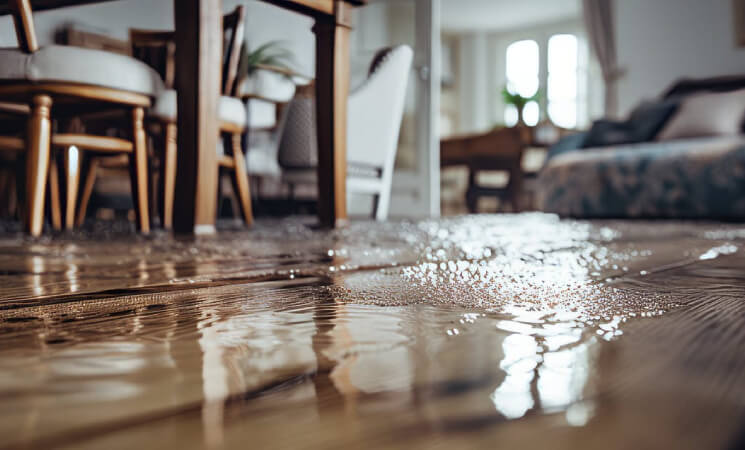Water damage in your home can lead to a host of problems, but one of the most insidious is mold growth. Mold can start growing within 24-48 hours of water exposure, potentially causing health issues and further damage to your property. This guide will help you understand, prevent, and address mold concerns following water damage.
Understanding Mold Growth
Mold thrives in moist environments and can spread quickly through spores. After water damage, conditions are often ideal for mold growth:
- Moisture
- Organic material (wood, drywall, carpet)
- Warm temperatures
- Poor ventilation
Health Risks Associated with Mold
Exposure to mold can cause various health issues:
- Respiratory problems
- Allergic reactions
- Skin irritation
- Headaches
- In severe cases, more serious health complications
Identifying Mold
Mold isn’t always easily visible. Look for:
- Discoloration on walls, ceilings, or floors
- Musty, earthy odors
- Warping of wood or drywall
- Peeling paint or wallpaper
- Increased allergy symptoms
Immediate Steps After Water Damage
To prevent mold growth:
- Remove standing water immediately
- Dry affected areas within 24-48 hours
- Remove wet carpets, furniture, and other items
- Increase air circulation with fans and dehumidifiers
- Discard porous materials that can’t be thoroughly dried
Professional Water Damage Restoration
For extensive water damage, search for “water damage restoration near me.” Professional services can:
- Extract water efficiently
- Use industrial-grade drying equipment
- Identify hidden moisture pockets
- Apply antimicrobial treatments to prevent mold growth
DIY Mold Prevention Techniques
For minor water damage:
- Clean and disinfect affected areas with a bleach solution or commercial anti-fungal product
- Ensure proper ventilation
- Monitor humidity levels (keep below 60%)
- Use mold-resistant products in high-risk areas
- Regularly inspect for signs of mold growth
When to Call Professionals
Consider professional mold remediation if:
- Mold covers a large area (more than 10 square feet)
- You have health concerns
- The water damage was from contaminated water (sewage, floodwater)
- You smell mold but can’t locate the source
- You have underlying health conditions that could be exacerbated by mold exposure
The Mold Remediation Process
Professional mold remediation typically involves:
- Inspection and assessment
- Containment of affected areas
- Air filtration
- Removal of mold-infested materials
- Cleaning of contents and belongings
- Drying of affected areas
- Restoration of removed materials
Dealing with Mold-Damaged Belongings
For items affected by mold:
- Non-porous items can often be cleaned with anti-fungal solutions
- Porous items (upholstery, carpets) may need to be discarded
- Valuable items may be salvageable with professional contents restoration near me services
Long-term Mold Prevention Strategies
After addressing immediate mold concerns:
- Fix any leaks or water intrusion issues
- Improve ventilation in high-humidity areas (bathrooms, kitchens, basements)
- Use mold-resistant paint in prone areas
- Regularly clean and maintain HVAC systems
- Consider using dehumidifiers in damp areas
Insurance Considerations
Check your insurance policy for mold coverage:
- Some policies cover mold remediation if it’s a direct result of a covered water damage event
- Document all water damage and mold growth with photos and detailed descriptions
- Keep receipts for all remediation expenses
Health Precautions During Mold Cleanup
If attempting DIY mold cleanup:
- Wear protective gear (N95 respirator, gloves, eye protection)
- Ensure good ventilation
- Avoid spreading mold spores to unaffected areas
- Consider temporary relocation during extensive cleanup
The Importance of Post-Remediation Testing
After mold remediation:
- Consider professional air quality testing
- Look for hidden mold growth in wall cavities or under flooring
- Monitor for any recurring mold issues
Addressing Structural Concerns
Mold can compromise structural integrity. If you notice:
- Softening of wood
- Crumbling drywall
- Sagging ceilings
Consult with a structural engineer or search for “fire damage repairs near me” services, as they often handle structural restoration as well.
Psychological Impact of Mold Issues
Dealing with mold can be stressful. Don’t overlook the psychological impact:
- Anxiety about health risks
- Stress over remediation costs
- Disruption of daily life
Consider seeking support if you’re feeling overwhelmed.
Education and Awareness
Empower yourself with knowledge:
- Attend local workshops on mold prevention
- Stay informed about mold risks in your area
- Educate family members on mold prevention techniques
The Role of HVAC Systems
HVAC systems can contribute to mold spread if not properly maintained:
- Regularly change filters
- Clean ducts and vents
- Consider professional HVAC cleaning after water damage
Natural Mold Prevention Methods
Some natural methods can complement professional treatments:
- Tea tree oil as a natural anti-fungal
- Increased ventilation with open windows (weather permitting)
- Baking soda for odor absorption
Vigilance is Key
Dealing with mold concerns post water damage requires a combination of quick action, thorough remediation, and ongoing prevention. While the process can be challenging, it’s crucial for maintaining a healthy living environment.
Remember, while DIY methods can be effective for minor issues, don’t hesitate to search for “water damage restoration near me” or mold remediation professionals for significant problems. Your health and the integrity of your home are worth the investment.
By staying vigilant, addressing water damage promptly, and taking proactive steps to prevent mold growth, you can protect your home and health from the insidious threat of mold. With the right approach, you can turn a potentially harmful situation into an opportunity to create a safer, healthier living space for you and your family.






